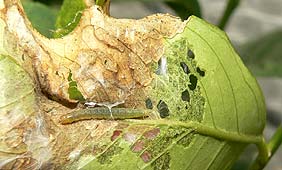

In the past couple of years my greenhouse citrus collection has been plagued by an
army of small caterpillars, causing considerable damage to foliage, flowers and
fruit. Some years ago, I used the caterpillar-specific biological control Bacillus
thuringiensis with considerable success, but it has recently been unavailable
in the UK - at least for small scale users. I have now received a form
of this control from the U.S. and hope to reduce the problem again. |
page created 26th March 2008 |

In the meantime, I have been researching exactly what this pest is - and have come
to the conclusion it is probably Epiphyas postvittana, known as the Light Brown Apple Moth. This member of the Tortrix moth family
is an Australian native now widespread in the UK. It is unfussy about its host
plant species. |
The eggs seem to be always deposited on the upper side of a leaf. They are easily
overlooked, appearing a bit like a scale insect. These pictures of an egg mass
were on a leaf of the bitter orange, Citrus aurantium, in March 2008. |
The larva, or caterpillar, is up to 2cms in length and is the damaging stage, feeding
on leaves as it grows. It often pulls the leaf edges together with silken
threads to form a protective canopy. Sometimes two or more neighbouring leaves
or flower buds are sown together in this way. The larva eventually pupates hidden
in the damaged or dying leaves, before emerging as an adult moth about 1cm long |
After spraying with the biological agent Bacillus thuringiensis (sold as "Dipel"),
any caterpillars which have eaten sprayed leaves stop feeding and soon die. However,
it is difficult to coat every leaf especially where they have been curled
together, so several repeat sprayings are required for effective control of
this pest. |